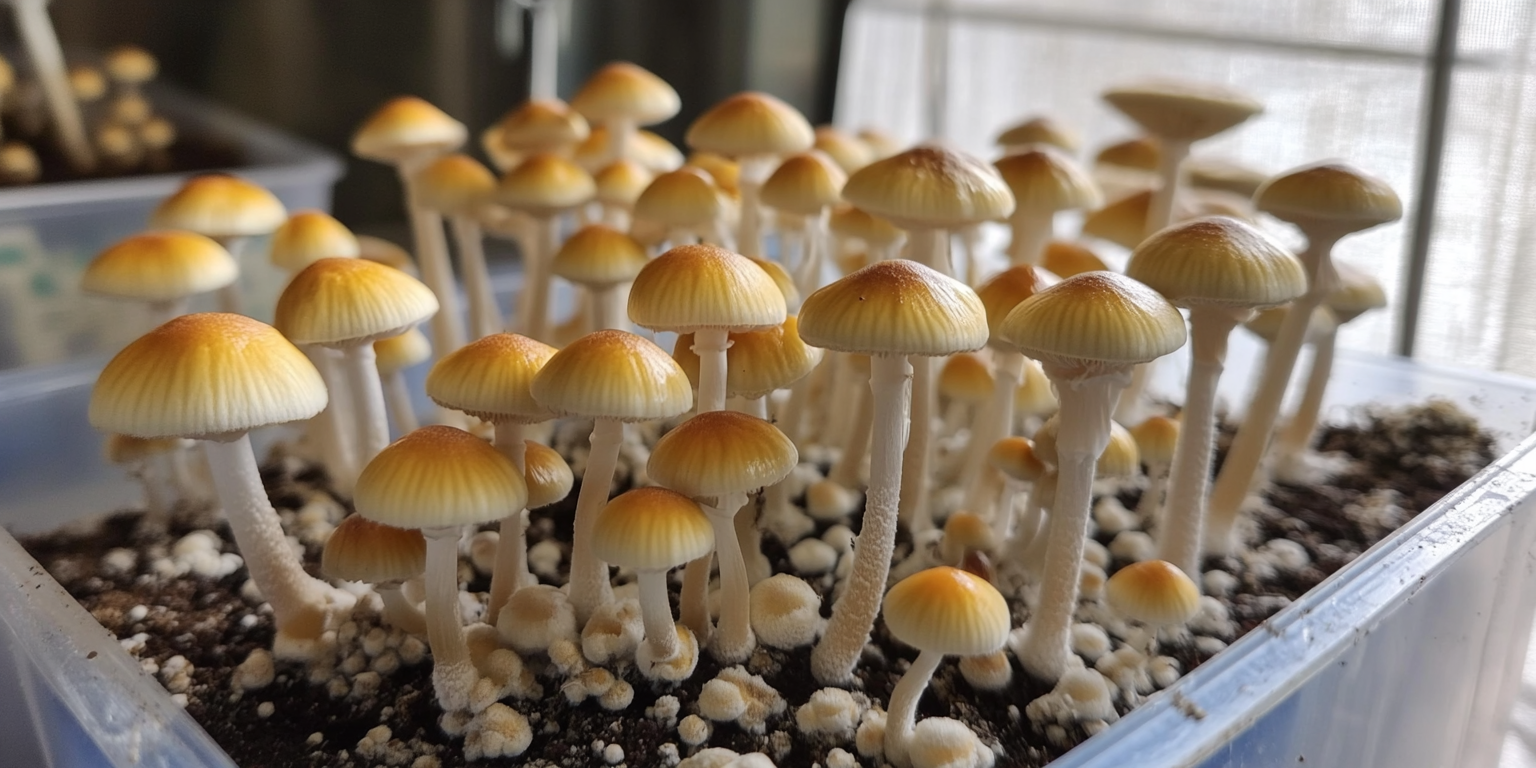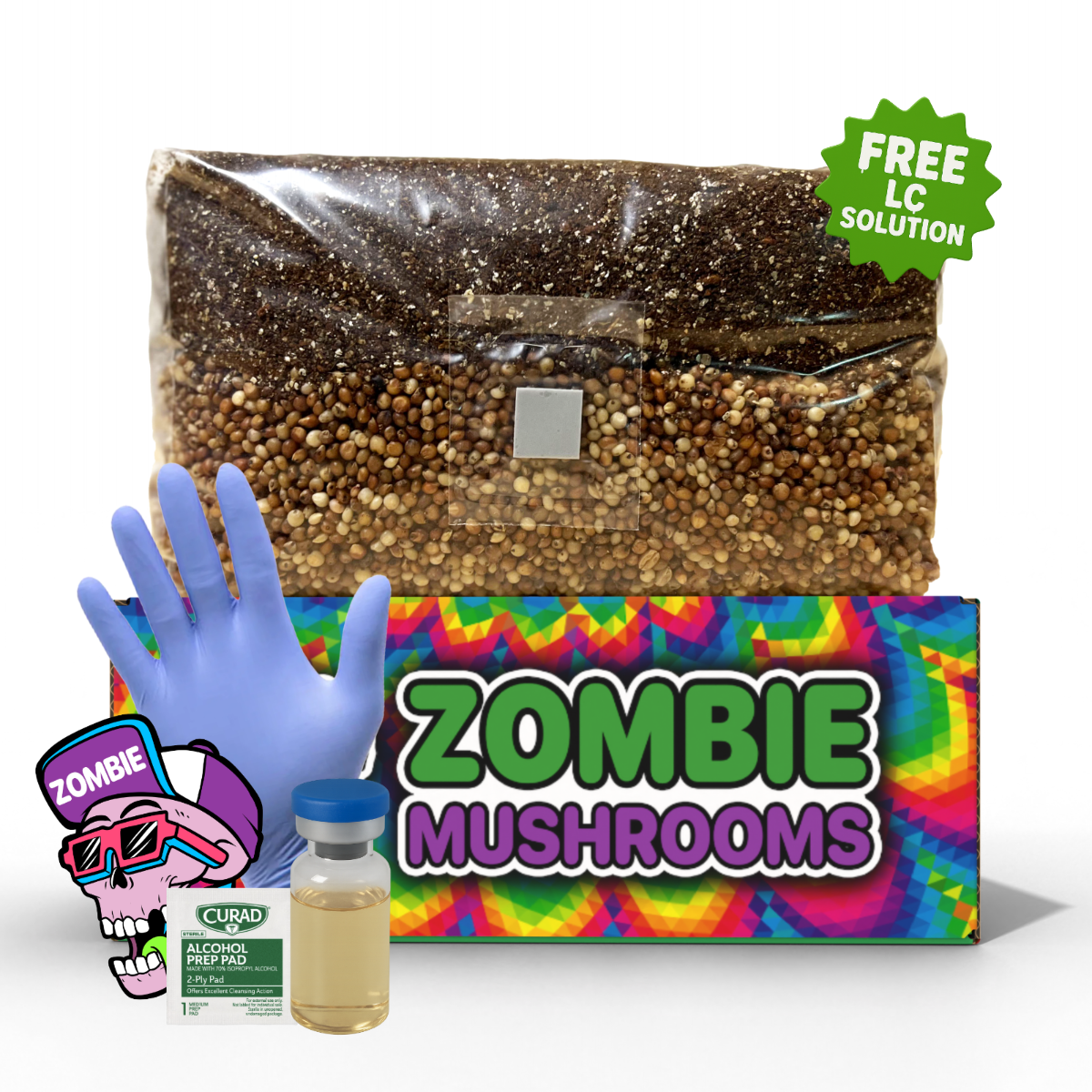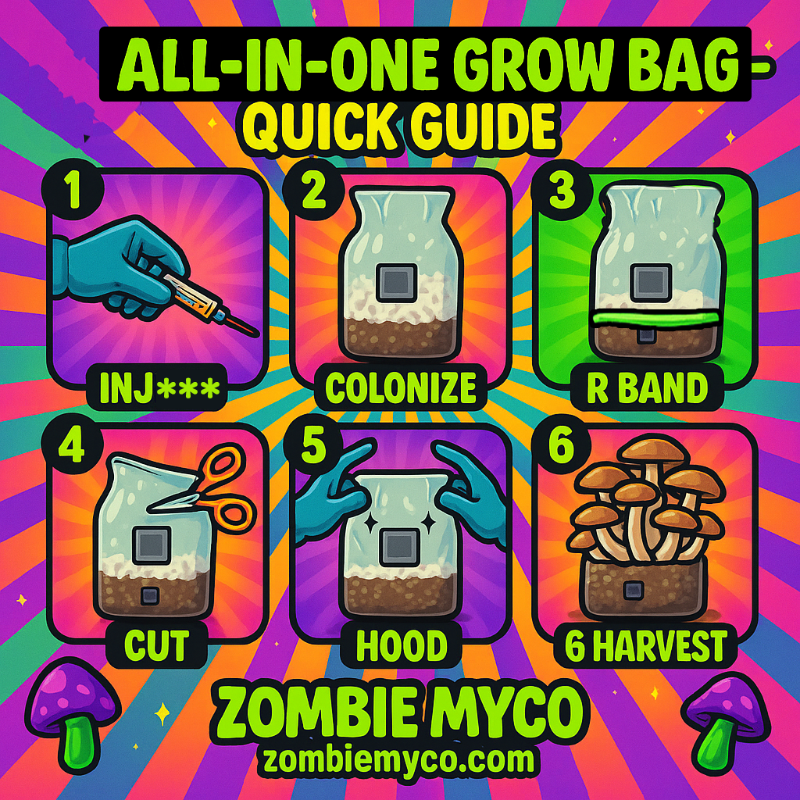⬇️ Prefer to listen instead? ⬇️
- 🌱 Fruiting conditions must be introduced only after complete substrate colonization to prevent contamination.
- 🌀 Fresh air exchange (FAE) and high humidity are the core environmental changes needed to initiate fruiting.
- 🔍 Visual signs like hyphal knots, condensation, and a fully white surface indicate readiness.
- 🌡️ Fruiting requires a slight temperature drop compared to the colonization phase.
- 🧪 Monotub setups are ideal due to their customizable airflow and humidity control, supporting high yields.
Starting the fruiting process at the right moment is one of the most important steps in mushroom cultivation. Whether you’re using a monotub setup or grow kits, understanding when to introduce fruiting conditions can make the difference between a bountiful flush and a frustrating flop. From spotting hyphal knots to tweaking humidity and airflow, this guide walks you through exactly how to know it’s time to fruit—and how to do it right. For reliable results and consistent harvests, our monotubs are designed with built-in airflow and contamination resistance, making them the ideal choice for healthy fruiting.

What Are Fruiting Conditions in Mushroom Cultivation?
In mushroom cultivation, fruiting conditions refer to an intentional shift in the growing environment that stimulates the mycelium to transition from vegetative growth to the development of fruiting bodies—the mushrooms. This stage needs a specific mix of environmental triggers to signal the mycelium it's time to reproduce.
Under typical cultivation conditions, colonization occurs in a warm, CO₂-rich, dark, and high-humidity environment. Once the substrate is fully colonized, growers must introduce changes that mimic natural forest floor cues—light, fresh air, lower CO₂, and a slight drop in temperature—to induce fruiting. Missing one or more of these signals can delay or even prevent fruiting entirely.
Understanding these variables isn’t just important—it’s foundational. Small mistakes, such as opening the tub too early or introducing too much airflow, can drastically affect your success.

Why the Timing of Fruiting Matters
In the controlled environment of mushroom cultivation, timing determines whether your substrate yields multiple productive flushes or invites contamination and stalls. Prematurely initiating fruiting conditions can have dire consequences. If the mycelium hasn’t fully colonized the substrate, the non-myc-covered areas can become breeding grounds for contaminants like trichoderma, penicillium, and bacterial blotch.
Delaying fruiting too long isn't ideal either. Sitting in stagnant, CO₂-rich conditions after full colonization can lead to substrate compacting or overlay—a condition where the top layer of mycelium grows too thick and creates a rubbery crust. Overlay prevents healthy pin formation, as the fruiting structures struggle to emerge through the hardened layer.
Stamets (2000) articulates it best: fruiting is a response to environmental stress, signaling it’s time for species propagation. You’re replicating this stress—but it must be done only once your substrate is fully prepared.

What Makes Monotub Setups Ideal for Fruiting?
Monotubs have become the go-to method for mushroom cultivators at every level, especially when growing species like Psilocybe cubensis. A monotub setup involves using a large plastic tote or container with strategically placed air exchange holes, allowing growers to maintain precise fruiting conditions with minimal ongoing adjustments.
Advantages of Monotub Setups:
- Humidity Retention: The enclosed design helps trap moisture, creating a high-humidity environment perfect for development of hyphal knots and pins.
- Customizable FAE: By taping over or stuffing the tub's holes with polyfill or filters, you can control when and how much air moves in and out.
- Ease of Maintenance: Once set up, monotubs require limited intervention, especially in contrast to systems like shotgun fruiting chambers or Martha tents.
- Low Cost, High Yield: Equipped with just a tote, some filters, and supplemental light, cultivators can grow large volumes without breaking the bank.
In the colonization phase, these holes are often sealed with micropore tape or left unstuffed in a low-air environment. With fruiting, filters are added or "cracked" to increase ventilation, simulating that outdoor moment of fresh air and light that naturally triggers mushrooms to fruit.
Additionally, monotub setups are scalable. Whether you're growing for hobby or small-scale distribution, the system offers a consistent, controllable, and replicable environment.

Visual Signs That It’s Time to Fruit
While timelines can range from 10 to 21 days or more depending on species and conditions, visual signaling is far more reliable.
Key Indicators to Look For:
-
Full Colonization:
- The substrate surface should be fully white and colonized with no visible brown substrate or bare patches.
- If you’re using a casing layer, it should show uniform colonization beneath and scattered patches on top.
-
Hyphal Knots:
-
Ideal Surface Moisture:
-
Absence of Contamination:
Tip: Take daily photos. Comparing days side-by-side is often the fastest way to gauge readiness.

Setting Up Environmental Conditions for Successful Fruiting
Once you’ve confirmed readiness, changing the conditions inside your grow environment to favor mushroom development should be methodical. The four pillars of fruiting—light, temperature, humidity, and FAE—must be balanced.
✔️ Fresh Air Exchange (FAE)
- Crucial to reducing CO₂ buildup.
- Without enough FAE, pins may form abnormally or abort altogether.
- Options: Unstuff a fraction of the holes, crack the lid open loosely, or use computer fans on timers for active FAE (more common outside monotubs).
✔️ Lighting
- Contrary to myth, mushrooms do “see” light—it helps orient fruiting bodies and encourages vertical growth.
- Use indirect light or a daylight-spectrum LED bulb. Set on a 12 hours on / 12 hours off cycle simulates nature.
- Avoid UV or high-heat bulbs which can dehydrate the substrate or stress the mycelium.
✔️ Humidity
- Aim for 85–95% relative humidity, especially during pinning.
- Tools like hygrometers can give you real numbers, but using your tub’s condensation and surface glisten is equally effective.
- You may need to lightly mist with a spray bottle if the tub dries out too quickly.
✔️ Temperature
- Dial down by 2–6°F from colonization environment.
- Psilocybe cubensis does best at 72–75°F during fruiting; species like lion’s mane prefer cooler, 60–70°F ranges.

Step-by-Step: How to Transition to Fruiting in a Monotub
- Wait Until Full Colonization: Patience is critical. Typically, no less than 14–21 days for most species.
- Introduce FAE: Replace tape with polyfill, remove foil sealed beneath the lid, or crack the lid open to allow passive airflow.
- Start Lighting Cycle: Set your LED light on a regular 12/12 timer.
- Adjust Humidity: Mist gently one to two times per day if necessary. You can also fan briefly after misting with the lid.
- Avoid Disturbing the Mycelium: Do not touch the surface or remove any forming hyphal knots, pins, or blobs.
Within 3–7 days, you should begin seeing pins, followed by rapid growth in another 3–5 days depending on strain and freshness of your culture.

Common Mistakes That Can Ruin a First Flush
Even seasoned growers fall into these traps:
- Initiating Fruiting Too Soon: A rush to see mushrooms can increase risks tenfold. Wait for that solid white surface and preferably hyphal knotting.
- Over- or Under-Misting: Too much water suffocates; too little, and nothing grows. Mist only the inner walls and allow condensation to drip slowly.
- Poor Ventilation: Insufficient FAE leaves you with leggy mushrooms, stunted growth, and possible contamination.
- Touching or Scraping the Surface: This damages delicate knots and pins or spreads contaminants.

Species-Specific Tips for Fruiting Conditions
Different mushrooms, different preferences. Tailor your monotub setup accordingly:
🍄 Psilocybe Cubensis
- Very forgiving.
- Likes temps of 72–75°F and develops well with moderate FAE.
- Requires misting during early pinning phase.
🧠 Albino Penis Envy (APE)
- Produces dense, slow-growing fruits often 50–100% slower than cubensis.
- Benefits from extended colonization (up to 30 days or more).
- Pinning may occur suddenly and inconsistently, so leave environment undisturbed once pins form.
🌬️ Oyster Mushrooms (Pleurotus ostreatus)
- Demand very high FAE—swap polyfill for loose filter patches or modify monotubs into mini-greenhouses.
- Fruit better in slightly cooler temperatures (~65°F).
- Mist frequently; they’re sensitive to dryness.
🧊 Lion’s Mane (Hericium erinaceus)
- Prefer 60–70°F, higher humidity (95%), and almost constant airflow.
- Don’t tolerate stagnant environments well—monotubs must be heavily modified for fresh air.

Post-Fruiting Optimization: Getting the Most From Your Flush
Maximizing yield doesn’t end with seeing beautiful caps.
Optimal Harvest Time
- Pick just before the veil breaks and the cap opens.
- This ensures full potency in Psilocybes and pristine texture in gourmet varieties.
Rehydration Techniques
- After each flush, soak the entire substrate block for 12–24 hours to replenish moisture lost.
- Use clean water, drain thoroughly, and return to fruiting conditions.
Substrate Longevity
- Nutrient-rich substrates like manure or coir can sustain 2–4 flushes depending on species.
- Discard blocks once contamination overtakes or yields severely decline.

Useful Tools to Maximize Fruiting Success
Take your monotub setup to the next level with these essentials:
- Digital Hygrometer/Thermometer: Ensures accurate climate monitoring.
- 12V USB Fans: Controlled airflow without drying out the tub.
- LED Grow Light (6500K): Timed light exposure improves pin setting.
- Monotub Kits from Zombie Mushrooms: Pre-fabricated with optimal design and food-grade plastic. Save time on hole placement, filtering, and lid design.

Troubleshooting: When Fruiting Doesn’t Go as Planned
Even with ideal setups, nature resists standardization.
- No Pins for 7+ Days: Re-evaluate surface moisture, airflow, and temperature. Sometimes mycelium needs more time post-colonization.
- Aborting Pins: Look for dry surfaces, aggressive direct light, or stale air.
- Green or Yellow Patches: Remove the tub from your grow space to prevent contaminant spread. Sometimes top-casing with more sterile substrate helps.
Observation Beats Impatience
Fruiting mushrooms in a monotub setup teaches you that nature follows its own timeline. Watch, document, measure—but most importantly, allow the cycle to unfold without rushing. When done correctly, mushroom cultivation can be one of the most rewarding biological projects you’ll ever pursue.
And if you’re just getting started, working with trusted sources like Zombie Mushrooms for equipment and culture supplies ensures fewer variables, allowing you to focus on learning the art of fruiting conditions and maximizing your harvest every flush.
Citations
Beyer, D. (2017). Mushroom Cultivation: A Practical Guide. Penn State Extension.
Cotter, T. (2014). Organic mushroom farming and mycoremediation: Simple to advanced and experimental techniques for indoor and outdoor cultivation. Chelsea Green Publishing.
Letcher, J. (2021). DIY Mycology: Growing Mushrooms at Home. SporeWorks Publications.
Stamets, P. (2000). Growing gourmet and medicinal mushrooms (3rd ed.). Ten Speed Press.



